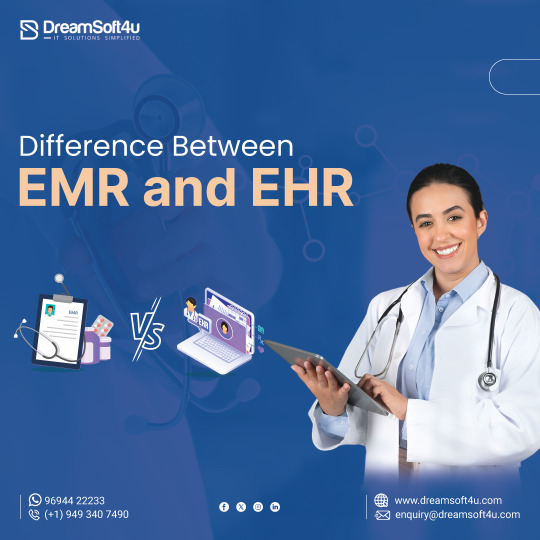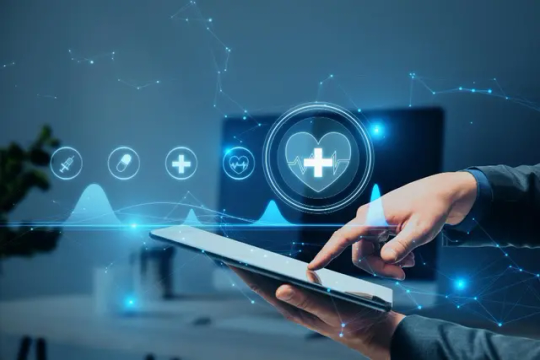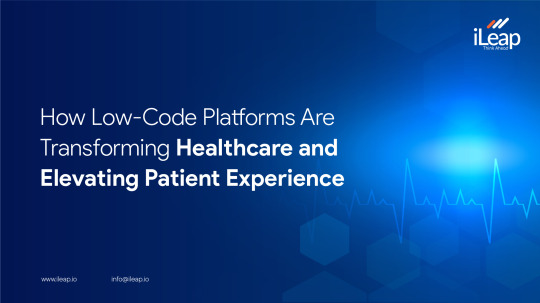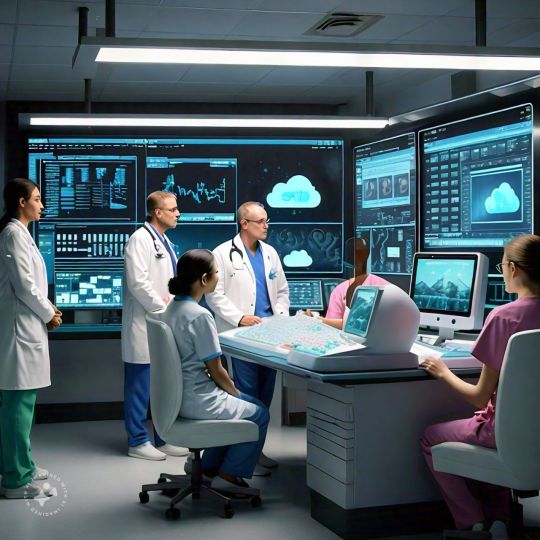#ehr benefits
Explore tagged Tumblr posts
Text

The healthcare industry has adopted technology widely and taken steps towards digital transformation. However, in order to make a complete digital shift, healthcare needs to streamline their data management. Although healthcare is one of the biggest sectors with huge amounts of data. It has to be secured and easily accessible. This is where two technological advancements, i.e., EMR vs EHR, play major roles.
#ehr software#emr software#emr system#emr vs ehr#ehr integration#benefits of ehr#emr integration#ehr benefits#benefits of emr#emr benefits
0 notes
Text

Struggling with managing patient records? Let's have a talk to check how we can provide you the best solutions for your challenges.
#EMR #medical records #medical billing # XyberMed
#benefits of electronic medical records#benefits of emr#define emr#ehr emr software#ehr/emr#electronic health medical records software#electronic medical record#electronic medical record definition#electronic medical record system#electronic medical record systems#electronic medical records#electronic medical records emr software#electronic medical records software#EMR#emr definition#emr ehr
0 notes
Text

Switching from paper documents to Electronic Health Record (EHR) software offers numerous advantages for patient care. EHR systems streamline information access, improve communication, reduce errors, and ensure better compliance with healthcare regulations. Discover how adopting EHR software can lead to enhanced patient safety, faster treatment, and a more efficient healthcare experience overall.
#Benefits of EHR software#EHR vs paper records#Electronic Health Records for patients#Patient care with EHR systems#Improving patient safety with EHR#Paperless patient record systems
0 notes
Text
#Benefits-of-IDD-EHR-Software#IDD-EHR-Software#best-EHR-software-provider-in-the-USA#best-ehr-for-idd
0 notes
Text

+Doctor is a comprehensive Practice Management software available for FREE. It streamlines the Clinic management workflow and provides various advantages to Clinicians. Install +Doctor today to end your clinical anxiety for good.
Benefits of +Ortho
Comprehensive ortho-specific clinical workflow
Software provides a seamless user experience for both providers and office administrators
Increase your convenience without compromising Security
Practices can collect demographics, insurance, referral, and other vital information
Software developed using more Versatile and Scalable Technology
A customized patient intake experience for your orthopaedics practice
Highly user-friendly control panel with electronic growth charts
#health & fitness#best ehr softwares#orthopedic emr#orthopedic emr practice management software benefits#orthopedic emr practice management software download free
0 notes
Text
Also preserved in our archive
By Stephanie Soucheray, MA
Two new large studies, one based on outcomes among US children and teens and the other on adults in Japan, show COVID-19 vaccines are protective against long COVID. Both studies were conducted when the Omicron strain of the virus was dominant, with the first also assessing the Delta variant.
In the first study, published in eClinicalMedicine, researchers measured the real-world efficacy of the Pfizer-BioNTech (BNT162b2) vaccine against long COVID in children and adolescents using data from 20 US health systems collected in as part of the RECOVER PCORnet electronic health record (EHR) Program.
Three cohorts were constructed: (1) adolescents 12 to 20 years old during the Delta phase (July 1 to November 30, 2021), (2) children 5 to 11 years and (3) adolescents 12 to 20 during the Omicron phase (January 1 to November 30, 2022). Outcomes were compared among those who received a first dose of the Pfizer vaccine to those with no receipt of COVID-19 vaccines.
In total, 112,590 adolescents (88,811 vaccinated) were included in the cohort for the analysis against the Delta variant, and 188,894 children (101,277 vaccinated), and 84,735 adolescents (37,724 vaccinated) were included for the analysis against the Omicron variant.
Preventing long COVID by averting infections For adolescents during the Delta period, the estimated effectiveness of the BNT162b2 vaccine against long COVID was 95.4% (95% confidence interval [CI], 90.9% to 97.7%). During Omicron, the estimated effectiveness against long COVID among children was 60.2% (95% CI, 40.3% to 73.5%), and it was 75.1% (95% CI, 50.4% to 87.5%) among adolescents.
The risk reduction in developing long COVID was largely linked to reducing the risk of COVID infection in the first place.
The effects through protecting againt SARS-CoV-2 infections were estimated as 0.04 (95% CI, 0.03 to 0.05) among adolescents during Delta phase, and 0.31 (95% CI, 0.23 to 0.42) among children and 0.21 (95% CI, 0.16 to 0.27) among adolescents during the Omicron period.
"The higher effectiveness of the BNT162b2 vaccine during the Delta phase, relative to the Omicron period, can be attributed both to its protection against Delta infections and to the fact that the primary benefit of the vaccine on long COVID stems from its capacity to prevent infections," the authors concluded. "With the genetic evolution of Omicron strains that generally are more highly transmissible with much lower severity of symptoms, infection rates are higher and vaccine effectiveness has been lower."
Three or more doses tied to less long COVID in women In the second study, a population-based analysis from Japan, researchers found the vaccine effectiveness of three or more doses of COVID vaccine against Omicron-related long COVID to be 30%, and against neurologic symptoms of long COVID it was 39%.
The protection, however, was found only in women. The study was published yesterday in Clinical Microbiology and Infection.
A total of 7,936 participants aged 20 to 69 years, who were infected from July 1 to August 31, 2022, were included in the study. Of those, 940 (11.8%) had at least one post-COVID, or long-COVID, symptom, according to a self-administered questionnaire.
Participants who had three or more COVID-19 vaccine doses had a 30% lower probability of long-COVID symptoms, with the odds ratio (OR) of 0.70 (95% CI, 0.53 to 0.90), although there was no association with one or two doses.
Furthermore, the risk reduction was seen in women with three or more COVID vaccine doses but not in men.
There was no significant association for respiratory symptoms, but those with three or more COVID vaccine doses reported fewer neurologic symptoms compared to unvaccinated participants (OR, 0.61; 95% CI, 0.45 to 0.83).
Study Links: 1st - www.thelancet.com/journals/eclinm/article/PIIS2589-5370(24)00541-8/fulltext 2nd - www.clinicalmicrobiologyandinfection.com/article/S1198-743X(24)00588-3/abstract (PAYWALLED)
#long covid#covid conscious#public health#mask up#wear a mask#pandemic#wear a respirator#covid#still coviding#covid 19#coronavirus#sars cov 2#covid19#covid is not over#covid vaccine#covid isn't over#covid pandemic#covid is airborne#covidー19#covid news
30 notes
·
View notes
Note
Prompt
If he wants to fuck Sektor up the ass, then Takeda needs to distract Cyrax so the Lin Kuei warrior can sneak in and steal whatever it is that she wants. And there is one way to distract her, by fucking the Shira Ryu warrior just the way she loves it. Whenever Takeda fucks Cyrax, it is like nothing around them matters.
Everyone won with this arrangement.
Sure, Takeda felt extremely guilty about deceiving the Shirai ryu warrior and letting their enemy benefit from it, and it would probably cause some kind of damage later on after the Lin Kuei put whatever plan they had in motion, but for the time being, bar the guilty conscience, everyone was having fun!
Cyrax was getting fucked Takeda just tha way she liked it, his cock up her ass with her fat booty clapping rhythmically, the warrior too lost in pleasure to realize what was happened around her or why Takeda was so eager to fuck in the particular way which made Cyrax face the wall. takeda was really enjoying how cyrax's ass swallowed his cock and the sounds of pleasure she made, and how her butt was jiggling from his thrusts as he slammed into her ass over and over, tryign to stay focused enough to pleasure her, and somewhere in another corner of the building, Sektor was making off with what she had come here for.
And once the theft was done, Takeda would go to a secret meeting, where Sektor woudl thank him for a job well done, and did so by letting him fuck her ass, all while humiliating him verbally, insulting how weak he was, how her ass was so much better than Cyrax's, since Takeda was ready to betray his friend for a chance at fucking Sektor's own butt, how it clapped even lewder, how it was fatter, jiggled more, how she coudl drain him dry with ehr asscheeks and make him cum over and over.
Takeda would feel even more guilty, but he would grip Sektor's waist eagerly, fuck her until eh couldn't cum anymore, and he would be ready to listen to her whenever she wanted him to distract Cyrax again.
2 notes
·
View notes
Text
How Low-Code Platforms Are Transforming Healthcare and Elevating Patient Experience

The healthcare sector is a highly evolving landscape. The current race for digitization has made it crucial for service providers to stay updated with the latest technology and regulations. Patient satisfaction is of the highest requirement, but inefficient processes, paperwork, and security concerns often hinder positive outcomes. To enhance speed, transparency, and efficiency, many providers are turning to low-code platforms, driving digital transformation.
Why Low-Code is a Perfect Fit for Healthcare
Low-code platforms enable both technical and non-technical users to build digital healthcare solutions. It simplifies healthcare operations, speeds-up processes and makes healthcare more accessible for patients.
Most healthcare professionals lack IT training, limiting their ability to use digital tools. Low-code bridges this gap by providing an intuitive interface for rapid, cost-effective app development. With scalable architectures and seamless third-party integration, these platforms improve workflows, patient care, and operational efficiency.
Key Benefits of Low-Code in Healthcare
Workflow Optimization and Automation:
Low-code platforms like iLeap streamline administrative and clinical processes. Automating billing, budgeting, and resource management reduces manual effort and errors. Tasks like appointment scheduling and reminders can also be automated, freeing up time for patient care.
Seamless Integration:
A majority of legacy healthcare enterprises rely on legacy systems which is often a major reason for downtimes and slow processes. A robust low-code platform integrates easily with existing software and third-party applications, ensuring unified workflows without IT disruptions.
Customizable Features:
Low-code solutions automate emails, manage patient records, and schedule appointments efficiently. Platforms like iLeap also support threshold management and escalation for timely responses to critical situations.
Enhancing Patient Care with Low-Code
Patient Registration and Records :
Custom applications streamline patient intake, scheduling, second opinions, and billing, reducing wait times and improving experiences.
Automated Appointment Reminders and Feedback:
By automating reminders and surveys, healthcare staff can focus on critical tasks, reducing no-shows and improving service quality.
Telehealth and Centralized Communication:
Legacy systems cause fragmented communication and delays. Low-code platforms facilitate telehealth solutions, including video consultations, secure messaging, and EHR integration, ensuring timely care.
Compliance and Accountability:
Regulatory compliance is crucial. Low-code solutions streamline reporting and documentation, ensuring transparency and adherence to guidelines. By 2030, on-demand compliance reports will be necessary, making digital transformation essential.
iLeap: Driving Digital Healthcare Transformation
iLeap enables healthcare providers to build secure, scalable applications tailored to their needs. By optimizing workflows, financial management, and patient experiences, iLeap helps organizations stay ahead in digital transformation.
Learn more about iLeap’s low-code application development platform. Schedule a call with us
2 notes
·
View notes
Text
What is Pharmacovigilance? Understanding Drug Safety and Risk Management

What is Pharmacovigilance? Pharmacovigilance (PV) is the science and practice of detecting, assessing, understanding, and preventing adverse effects or other drug-related problems. Its primary goal is to ensure that the benefits of medicinal products outweigh their risks, thus safeguarding public health.
This discipline extends across the entire lifecycle of a drug, from pre-market clinical trials to post-marketing surveillance, encompassing the global monitoring of medicinal products.
Core Objectives of Pharmacovigilance Identifying Adverse Drug Reactions (ADRs): PV seeks to detect adverse effects, especially those that are unexpected or serious, arising from the use of medicinal products.
Ensuring Drug Safety: By monitoring and managing risks, pharmacovigilance contributes to the safer use of medicines.
Educating Stakeholders: Healthcare providers, regulatory authorities, and patients are informed about potential risks and proper usage of drugs.
Regulatory Compliance: Pharmaceutical companies must adhere to international standards and report safety data to regulatory bodies like the FDA, EMA, and WHO.
Importance of Pharmacovigilance Protecting Patient Health: By identifying potential risks early, pharmacovigilance minimizes harm to patients and ensures the safety of medicinal products.
Supporting Regulatory Decisions: Comprehensive safety data help regulatory agencies make informed decisions about the approval, withdrawal, or restriction of drugs.
Enhancing Pharmaceutical Innovation: A robust PV framework fosters confidence in the pharmaceutical industry, encouraging innovation while ensuring public safety.
Global Harmonization: Pharmacovigilance facilitates uniform safety standards across countries, promoting international cooperation in drug safety monitoring.
Challenges in Pharmacovigilance Data Overload: The influx of safety data from clinical trials, real-world use, and social media presents challenges in effective monitoring.
Complex Regulations: Varying regulatory requirements across countries require significant expertise to navigate.
Technological Integration: Adopting advanced tools like AI and machine learning for signal detection and data analysis is a complex but necessary step forward.
Public Awareness: Educating patients and healthcare professionals about reporting adverse events remains a significant hurdle.
Technological Advances in Pharmacovigilance The integration of technology is revolutionizing pharmacovigilance. Tools such as artificial intelligence (AI), big data analytics, and machine learning are enhancing signal detection, enabling quicker identification of potential risks. Real-world evidence from wearable devices and electronic health records (EHRs) provides real-time insights into drug safety.
The Future of Pharmacovigilance As global healthcare systems evolve, pharmacovigilance will play an increasingly pivotal role. The focus will shift towards personalized medicine, where monitoring individual patient responses to drugs will become central. Additionally, greater emphasis on patient engagement and transparent communication will redefine the relationship between healthcare providers and patients.
Conclusion Pharmacovigilance is the cornerstone of drug safety, ensuring that the medicines we rely on are both effective and safe. By bridging the gap between pharmaceutical innovation and patient safety, it upholds the integrity of healthcare systems worldwide.
As technology and global collaboration continue to advance, pharmacovigilance will remain a critical field in protecting and improving public health, shaping a safer and more informed future for all.
#pharmacovigilance service#pharmacovigilance#clinic#clinical research#clinical trial management#clinical trial operations#clinical trial monitoring
2 notes
·
View notes
Text
Medical Coding and Billing Training

Transorze results offers an exceptional Medical Coding and Billing Training Program in Kerala, India, designed to equip scholars with the chops necessary for a successful career in healthcare assistance. There’s a blog script that highlights the crucial features and benefits of this training program.
Course Overview
Medical billing and coding programs prepare students for careers in the healthcare industry, focusing on the essential functions of coding healthcare services and managing billing processes. These roles are critical for ensuring that healthcare providers receive accurate reimbursement from insurance companies.
Key Learning Objectives
Students will learn to:
Understand Medical Terminology: Build and interpret medical terms relevant to various healthcare settings.
Apply Coding Systems: Utilize coding systems such as ICD-10-CM, CPT, and HCPCS to accurately code diagnoses and procedures.
Navigate Insurance Processes: Gain insights into health insurance principles, including the claims process and regulatory compliance (HIPAA).
Utilize Software Tools: Develop proficiency in electronic health records (EHR) and medical billing software, preparing them for practical applications in real-world scenarios.
Prepare for Certification Exams: Students are typically prepared to take national certification exams like the Certified Billing and Coding Specialist (CBCS), Certified Professional Coder (CPC), or Certified Coding Associate (CCA) upon course completion
Unleash Your Future with Transorze Medical Coding and Billing Training
Are you looking to launch a satisfying career in the healthcare sector? Look no further than Transorze results, the leading provider of medical rendering training in Kerala. Our comprehensive program is acclimatized to meet the requirements of aspiring coders and billers, icing you gain the moxie needed to exceed in this high- demand field
Why Choose Transorze for Medical Coding Training?
CPC- Certified Coaches Our preceptors are n't only largely educated but also CPC- certified professionals. They bring a wealth of knowledge from the field of medical coding, icing you admit top- notch education from assiduity experts
Hands- On Training At Transorze, we believe in literacy by doing. Our training includes hands- on experience and exposure to real- life scripts, preparing you for the challenges you'll face in your career.
Tailored literacy Material We give largely delved and streamlined training accoutrements that feed to the rearmost assiduity norms. This ensures that you're well- equipped with applicable knowledge and chops
100 Placement Assistance We're committed to your success
Transorze offers comprehensive placement backing, helping you secure a position in estimable healthcare associations upon course completion.
Access to rearmost AAPC Accoutrements Our scholars profit from access to the rearmost coding accoutrements from the American Academy of Professional Coders( AAPC), which enhances their literacy experience and prepares them for instrument examinations
Course Highlights
In- Depth Class Our class covers essential motifs similar as medical language, rendering systems( ICD- 10, CPT, HCPCS), compliance regulations, and more.
Flexible Learning Options We offer both online and offline classes, allowing you to choose a mode that fits your schedule and literacy style.
probative literacy Environment With a focus on pupil satisfaction, our faculty provides individualized attention to insure that every pupil thrives
Career openings
Upon completing our Medical Coding and Billing Training, graduates can pursue colorful places in the healthcare assiduity, including
Medical Coder
Medical Biller
Health Information Technician
Compliance Officer
Join Us moment!
Do n’t miss out on this occasion to elevate your career prospects. Enroll in Transorze Medical Coding and Billing Training program moment and take the first step towards a fulfilling career in healthcare. For further information or to register, visit our website at Transorze results or communicate us directly.
3 notes
·
View notes
Text

Technology is continually evolving, and data storage requirements increase. Healthcare businesses must plan for ongoing investments in Electronic Health Record systems. This requires updates to keep up with advancing technology and sufficient data storage space. A long-term strategy for continual development is critical to ensuring EHR systems’ survival in the face of a changing industry.
0 notes
Text
The Clinical Benefits of Electronic Health Records Systems

The adoption of Electronic Health Records (EHRs) began in the early 2000s, due to advancements in technology, and the need for better patient data management. In 2009, the Health Information Technology for Economics and Clinical Health (HITECH) Act was passed, which provided financial incentives through a Medicare and Medicaid EHR incentive program, later known as Meaningful Use. Between 2011 and 2015, a growing number of providers adopted EHRs to qualify for federal incentives and avoid penalties. Then in 2020, the COVID pandemic hit creating a sudden need for patients to be treated remotely. The Office of National Coordinator for Health Information Technology (ONC) estimated that as of 2020, approximately 88% of all U.S. physician offices used some form of electronic health records.
Leading EHR Software have provided significant benefits practice productivity and patient care. Providers gain access to patient data in real time. Everything from lab results to current medications is available at a glance. This reduces errors and supports more informed decision-making. Physicians can easily and effectively coordinate care with other providers, resulting in better patient outcomes and overall patient experience.
Read more:https://prognocis.com/electronic-health-records-ehr-benefits/
#benefits of ehr software#ehr software benefits#emr software benefits#best ehr software#electronic health record software#electronic health records solutions#prognocis#prognocis ehr software
0 notes
Text

#biller medical#billing and coding medical#billing medical software#billing services medical#billing software medical#bills medical#can medical bills affect credit#can medical bills affect credit rating#can medical bills affect your credit#can medical bills affect your credit score#evicore prior authorization#how long does prior authorization take#medicare prior authorization#pre authorization#prior authorization#prior authorization for medication#prior authorization processing#prior authorization specialist#what is prior authorization#who is responsible for getting prior authorization#benefits of electronic medical records#benefits of emr#define electronic medical record#define emr#ehr emr software#ehr/emr#electronic health medical records#electronic medical health records software#electronic medical record#electronic medical record definition
1 note
·
View note
Text
Explore the benefits of multi-specialty Electronic Health Records (EHR) solutions from EMR-EHRs. Streamline your practice with a customizable, unified system that integrates patient data across various specialties. Improve care coordination, enhance collaboration, and ensure compliance with secure, scalable EHR systems designed for healthcare providers of all sizes. Learn more today!
#Multi-specialty EHR#Electronic Health Records solutions#Multi-specialty EHR system#Healthcare practice EHR system#Customizable EHR software#EHR system benefits#EHR system for specialties
0 notes
Text
Revolutionizing Healthcare: The Role of Cloud Computing in Modern Healthcare Technologies
In today’s digital era, cloud computing is transforming industries, and healthcare is no exception. The integration of cloud computing healthcare technologies is reshaping patient care, medical research, and healthcare management. Let’s explore how cloud computing is revolutionizing healthcare and the benefits it brings.

What is Cloud Computing in Healthcare?
Cloud computing in healthcare refers to the use of remote servers to store, manage, and process healthcare data, rather than relying on local servers or personal computers. This technology allows healthcare organizations to access vast amounts of data, collaborate with other institutions, and scale operations seamlessly.
Download PDF Brochure
Key Benefits of Cloud Computing in Healthcare
Enhanced Data Storage and Accessibility Cloud technology allows healthcare providers to store massive volumes of patient data, including medical records, images, and test results, securely. Clinicians can access this data from anywhere, ensuring that patient information is available for timely decision-making.
Improved Collaboration Cloud-based healthcare platforms enable easy sharing of patient data between healthcare providers, specialists, and labs. This facilitates better collaboration and more accurate diagnoses and treatment plans, especially in multi-disciplinary cases.
Cost Efficiency The cloud reduces the need for expensive hardware, software, and in-house IT teams. Healthcare providers only pay for the resources they use, making it a cost-effective solution. Additionally, the scalability of cloud systems ensures they can grow as healthcare organizations expand.
Better Data Security Protecting sensitive patient information is critical in healthcare. Cloud computing providers invest heavily in data security measures such as encryption, multi-factor authentication, and regular audits, ensuring compliance with regulatory standards like HIPAA.
Telemedicine and Remote Patient Monitoring Cloud computing powers telemedicine platforms, allowing patients to consult with doctors virtually, from the comfort of their homes. It also enables remote patient monitoring, where doctors can track patients' health metrics in real time, improving outcomes for chronic conditions.
Advanced Data Analytics The cloud supports the integration of advanced data analytics tools, including artificial intelligence (AI) and machine learning (ML), which can analyze large datasets to predict health trends, track disease outbreaks, and personalize treatment plans based on individual patient data.
Use Cases of Cloud Computing in Healthcare
Electronic Health Records (EHRs): Cloud-based EHRs allow healthcare providers to access and update patient records instantly, improving the quality of care.
Genomics and Precision Medicine: Cloud computing accelerates the processing of large datasets in genomics, supporting research and development in personalized medicine.
Hospital Information Systems (HIS): Cloud-powered HIS streamline hospital operations, from patient admissions to billing, improving efficiency.
Challenges in Cloud Computing for Healthcare
Despite its numerous benefits, there are challenges to implementing cloud computing in healthcare. These include:
Data Privacy Concerns: Although cloud providers offer robust security measures, healthcare organizations must ensure their systems are compliant with local and international regulations.
Integration with Legacy Systems: Many healthcare institutions still rely on outdated technology, making it challenging to integrate cloud solutions smoothly.
Staff Training: Healthcare professionals need adequate training to use cloud-based systems effectively.
Request Sample Pages
The Future of Cloud Computing in Healthcare
The future of healthcare will be increasingly cloud-centric. With advancements in AI, IoT, and big data analytics, cloud computing will continue to drive innovations in personalized medicine, population health management, and patient care. Additionally, with the growing trend of wearable devices and health apps, cloud computing will play a crucial role in integrating and managing data from diverse sources to provide a comprehensive view of patient health.
Conclusion
Cloud computing is not just a trend in healthcare; it is a transformative force driving the industry towards more efficient, secure, and patient-centric care. As healthcare organizations continue to adopt cloud technologies, we can expect to see improved patient outcomes, lower costs, and innovations that were once thought impossible.
Embracing cloud computing in healthcare is essential for any organization aiming to stay at the forefront of medical advancements and patient care.
Content Source:
2 notes
·
View notes
Text
Ghost of girlfriends past-part 2
Tommy x Greta Jurossi. Greta joins Ruby for a telling of the Christmas Carol

_____________________________________________________________
___________________________________________
Ghostly Readings
“Marley was dead: to begin with. Old Marley was as dead as a door-nail.” Exhaustion had settled into the older man’s voice lending more gravel and grit then normal. He could feel the rumble in his chest.
He’d made the added mistake of reclining on the most comfortable chair in his daughter's room near the fireplace. He was dead on his feet tonight.
“How'd he die? Is he a ghost?” Ruby sat up a little straighter from her little black chair. She was clutching her teddy bear clearly full of energy and vibrating with excitement for the Christmas Carol to finally be read to her.
Charlie hadn’t been interested this year, much to Ruby’s benefit. Time alone with her father was rare and deeply relished by the little brunette girl.
“Luv, daddys had a long day, eh. He probably dies of old age. It’s been far too long since I read the book. I can tell you, according to Dickens, he's dead and yes, he’s a ghost. The whole book has ghosts in it.” He smiled as she squealed. After Halloween when he’d discovered her and Greta having tea parties in her bedroom, Ruby had been eager to devour anything written or oral about ghosts.
She’d practically driven Polly criminally insane asking her about visions and the spirit world. At least Polly had someone to pass her knowledge unto.
Ruby had even sought out Johnny Doggs wife, Esmeralda, to teach her about divinations and spirit guides.
“Ruby, can I please get a paragraph in? Mr. Dickens might answer your questions if you are patient and let me read more than two sentences.” He laid the open book down on his lap and rubbed his eyes. He felt awful snapping at her on Christmas Eve.
“I’m just so excited!” She bounced on her seat and sighed. Waiting was hard when you were six.
“I seem to remember an impatient young man asking me questions as I read this story too.” Greta Jurossi’s melodic voice filled his head causing his eyes to snap open.
He sat next to Ruby, curled up on the floor. A wide grin spread across her immortally youthful face. Her warm honey brown eyes glinted , the fire reflecting off her Chocolate brown hair. She was dressed in all black, her funeral clothing. She still stirred feelings within his now tight chest.
“Hello Greta. Come to listen to me read again?” He gently teased her. Remembering fondly all the times she’d read to him, and later, during her sickness, he’d read to her till the consumption consumed her.
“Ruby, your father would have me read to him for several months, claiming because he travelled so much as a child he didn’t read well, then for my birthday he made a mistake and read me my birthday card. I caught him.” They both laughed at the sweet memory. He’d done many things to get her to spend time with him.
“You have a lovely voice and it made you spend time with me. Neither one of us complained at the time.” She laughed, her sweet high pitched giggle echoing off the tall walls in Ruby's room.
The little girl was enchanted with the display of affection between her father and her ghostly half mother. Her father had taken time after Halloween to explain that Lizzie had grown her and given ehr life, Ruby definitely had Greta’s spirit thought, fittingly enough because she was conceived while he’d been thinking about his first love.
“You are such an imp.” Greta teased.
Thomas went back to reading, finding himself more awake with the ever growing questions from Ruby and the laughter at his expense from Greta. He’d gotten so lost in reading he’d been surprised when Greta had cleared her throat. She brushed Ruby's hair out of her face. The little girl had fallen asleep on her shoulder. Greta looked at the clock. It was getting late.
A sinking feeling fell deep into his empty stomach, dinner long forgotten. Probably a good thing, he knew what was coming. He hated this part. He hated when Grace left too. His soul always wanted to go with her.
“What?” He asked. He knew. He was just hoping falsy for a different answer.
“It’s almost midnight.” They both knew what she was saying. She could only exist on this side of the veil for so long.
“Yes, it is.“ He felt nineteen again. Pining for the next time he could see her, regretting the short amount of time he’d had with her.
“Ruby says she’ll see you on her birthday.” Tommy mused. He was making conversation hoping to keep her lingering longer.
“Yes, seven isn't it….Tommy I……” Greta looked down at her crochet gloved hands. She was twisting her fingers violently. He hated when she did that. It was a habit she’d had in life, when she was nervous and didn’t want to say something, usually a hurtful truth of some kind.
He sighed audibly. He was going to need a whiskey after she left. Maybe more than one with the looks of her pained contorated grief filled face.
“ Why do you look sad, Greta?” He stood and walked toward her, extending a hand to help her off the floor. She accepted after a few moments. She was stalling. That was new.
“That’ll be the last time you see me Tommy, at least until you cross over.. I have to bring someone over….then I’ll get to rest outside of the plane for awhile.” Her voice was so soft and low, he’d almost missed what she said. She wasn’t coming back.
He wondered how Ruby would take the news when her birthday came and went, no Greta?
“I never forgot you.” He rubbed her palm with his thumb. He’d missed holding her hand.
“I know, it’ll be an interesting reunion when you finally cross over, all these women who loved you.”She laughed again, pulling them both out of the melancholy mood. He shook his head and just as quick as a head shake, She was gone in a fog.
“See you soon Miss Jurossi.”
_______________________________________________
This is the end of this series. If you watched the show you know why. Thank you for taking the time to write me back and read my work. I appreciate it.
#peaky blinders fanfic#thomasshelby#gretajurossi#ruby shelby#angst#bittersweet#christmas fluff#fluff#ghost#christmas carol#charles dickens
1 note
·
View note